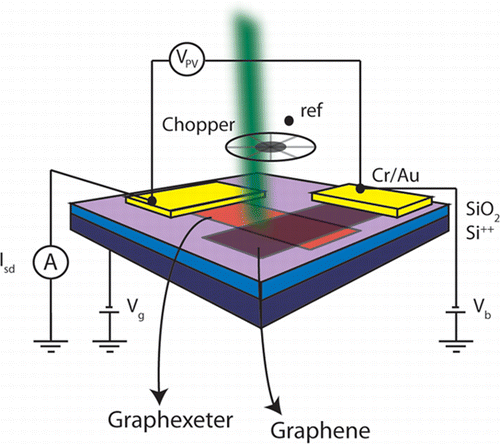It doesn’t sound much like dispassionate, objective scholarly reporting, but the University of Exeter in England headlines its report on a University-created breakthrough material, “Revolutionary new device joins world of smart electronics.”

There’s more to the transparent film than meets the eye in this schematic diagram of Exeter’s see-through solar material
Layering graphene and the GraphExeter, a material obviously headed for product marketing, gives a “new flexible, transparent, photosensitive device” that can lead to solar-powered clothing able to charge the wearer’s cell phone, “intelligent” windows that can “harvest light and display images,” and just maybe (in this writer’s dreams) help power electric cars and airplanes.
GraphExeter, Exeter claims, is the best known room temperature transparent conductor and with graphene – the thinnest conductive material – the pair make for great potential. Researchers developed GraphExeter by sandwiching molecules of ferric chloride in between two layers of graphene.
According to the University, “Saverio Russo, Professor of Physics at the University of Exeter said: ‘This new flexible and transparent photosensitive device uses graphene and graphExeter to convert light into electrical signals with efficiency comparable to that found in opaque devices based on graphene and metals.
“’We are only just starting to explore the interfaces between different materials at very small scales and, as this research shows, we are revealing unique properties that we never knew existed. Who knows what surprises are just around the corner.’”
Since the layers are made of graphene and the Exeter material, the material is only a few atoms thick and thus ultra-lightweight, but can match heavier, opaque solar cells in their efficiency at converting photons to energy. Because the material contains no metal, it avoids the haziness that prevents such materials from being totally transparent and thus allows the graphene and GraphExeter sandwich to detect light from the entire visible light spectrum.
This work was financially supported by the Engineering and Physical Sciences Research Council (EPSRC).
Findings by the Exeter research team, including Freddie Withers, Thomas Hardisty Bointon, Monica Felicia Craciun, and Saverio Russo appear in the journal ACS Nano for April 19.
The abstract includes a somewhat proud conclusion.
“Transparent conductors based on few-layer graphene (FLG) intercalated with ferric chloride (FeCl3) have an outstandingly low sheet resistance and high optical transparency. FeCl3-FLGs outperform the current limit of transparent conductors such as indium tin oxide, carbon-nanotube films, and doped graphene materials. This makes FeCl3-FLG materials the best transparent conductor for optoelectronic devices.”

